Important information regarding updates
We have originally published this article on March 18th, 2020 and since it had a great response, we kept on updating in with the latest information regarding 3D printed protective shields. Our open-source shield design became popular among 3D printing communities and people in the whole world joined forces to bring these shields to frontline staff – to medical professionals, firemen, police officers… to everyone who needed one. It’s an amazing community-driven effort.
People keep finding new ways to help. Many of you started printing these shields, those without 3D printers help with production of the visors, others are remixing the current design to improve its features.
We would like to express our sincere thanks to everyone who participates in this effort! 3D printing communities are truly amazing!
To make the navigation in this article a bit easier, we have added a list of contents. You can also find more detailed information and a timeline on Prusa3d.com.
Table of contents:
- Prusament PETG Orange for PPE
- US shield design available
- Community Groups and headband cover
- RC3 Version
- Feedback we received
- RC2 Update
- From design to mass 3D printing – the original article
2.4 Introducing Prusament PETG Orange for PPE
In reaction to the acute shortage of Personal Protective Wear (PPE) for frontline staff, many people started producing PPE on their own using 3D printers. To support makers all over the world, we decided to add Prusament PETG Orange for PPE to our e-shop. It’s a heavilly discounted high-quality PETG material, which is perfect for production of these shields (the headband and chin parts). It still has the same composition as our standard Prusament PETG Orange and we’ve been using this type of material on our printing farm for a long time.
Since we wanted to speed up the production and get the material to our customers as quickly as possible, we lowered the manufacturing precision from our usual ±0.02mm to ±0.03mm and the winding is not as perfect as on standard Prusaments.
2.4. The difference between US and EU shields
We have released a slighly modified version of the shield, which is more suitable for the US – the design was adjusted to fit American size sheets (11×8.5”) and American triple hole punch (distance 4 1/4”, hole radius 1/4”). Print files and more info are available at PrusaPrinters.org
30.3. Groups and headband cover
We’ve released GROUPS on PrusaPrinters. You can share information, collaborate and help others with (not only) the production of protective shields. You can learn more about groups in our article.
We’ve also released a cover for the headband, which is useful for very high-risk environments as they provide even better protection.
Finally, we’ve released speed optimized print files for the RC3 stacked version.
26.3. version RC3
We’ve created a new page, where you’ll find all the information about the 3D printed Face Shields – https://www.prusa3d.com/covid19/
Sterilizing / disinfection guide – we’re updating this guide with lab testing results. We even have lab testing with live coronavirus in progress. Huge thanks to all labs and hospitals that help us verify disinfection methods!
We’ve also released the RC3 version (download here) – changes from RC2:
- Removed hexagonal holes for faster printing speeds
- With faster printing we use on our farm, some pieces had sharp points and based on testing, the venting is not needed as much
- Several optimizations for stack printing
- New print files with 4 headbands stacked on top of each other
- Stacking headbands is a great idea by the community, especially useful for overnight printing
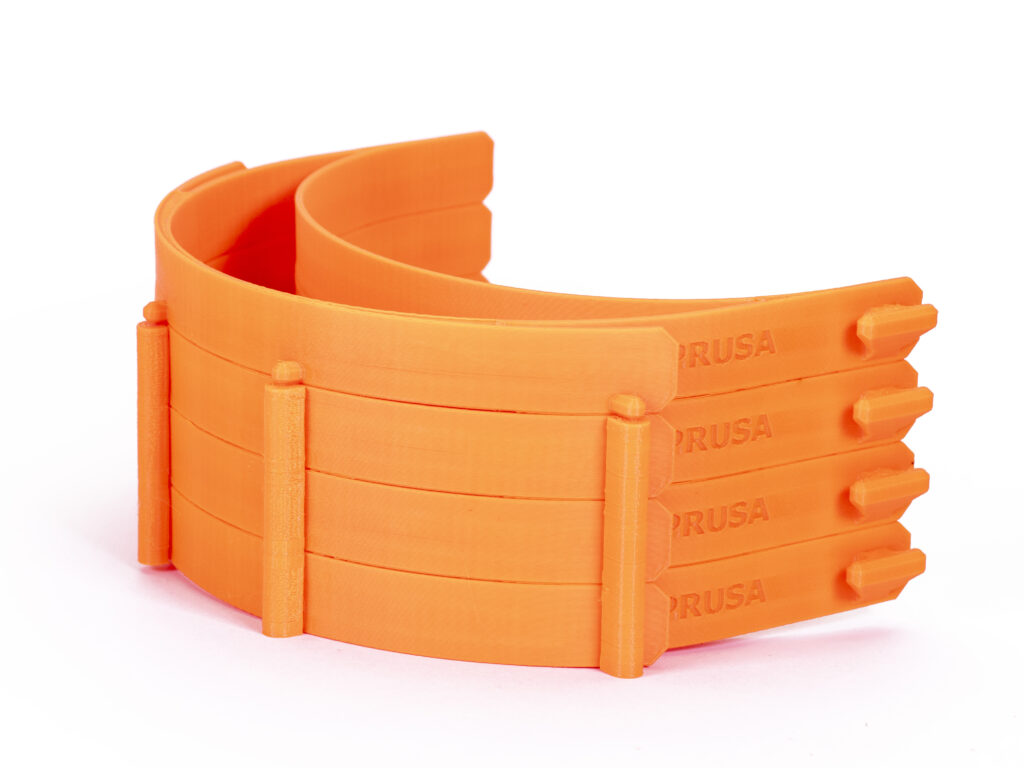 A stacked version of the RC3 headbands, especially useful for overnight printing
A stacked version of the RC3 headbands, especially useful for overnight printing
24.3.
The 3D printing communities all around the world are printing Face Shields for local medics, this is amazing! And we’ve donated over 10 000 Face Shields🎉 We keep getting awesome feedback and are already testing the RC3 version, stay tuned for more updates!
20.3. – update RC2
I’ve promised I’ll keep you updated and a lot has changed since the release of our face shield 48 hours ago, so let’s get into it.
As soon a the word got out about our face shield, we’ve received dozens of requests from local hospitals, ambulances, firefighters, dentists, senior houses… the list goes on. We’ve distributed the current stock as best as we could (over 1000pcs) and collected a great amount of feedback. Based on that we’ve re-designed the printed parts.
Differences between RC1 and RC2:
- Increased wall thickness (slightly stiffer and more durable)
- Inner wall from 1.5 mm to 2 mm
- Outer wall from 2 mm to 2.5 mm
- The headband is no longer printed compressed
- Lower pressure on the temple
- The visor was moved further away from the forehead
- This allows a better fit over bigger respirators and protective goggles
- The printed part now has an extension for the visor (the visor curves less than the headband)
For now, both RC1 and RC2 versions are relevant. RC1 lets you fit more printed parts on a single print bed. However, if the maximum yield isn’t the priority, RC2 provides slightly better protection and is more comfortable to wear.
If you want to manufacture shields for others
PLEASE READ THIS CAREFULLY
- Act as if you were infected by the COVID-19 virus. Wear a face mask and a fresh pair of gloves when collecting each batch of printed parts. Store the parts immediately in a sealable bag.
- Talk with whoever you’re making the shields for, let them know about your manufacturing environment
- There is still debate about how long the virus survives on plastic, but most sources mention 2-3 days. That means that by letting the packed face shields sit for 2-3 days before distributing them, you’ll greatly reduce risk of transmission
- Do not store the entire stock in one place, minimize the risk of cross-contamination
From Design to Mass 3D printing of Medical Shields in Three Days
Hello everyone, times are tough so I will keep this short and to the point. The 3D printing community is amazing! We are all problem solvers and enjoy building things not only for our lives but also for others. In the past few weeks, we have received many messages with respirator designs, medical ventilators and other devices (that are missing in hospital’s warehouses right now) – you are looking for ways to help with this global pandemic and that’s a great thing. The worldwide demand for these devices is so huge, that in some countries, even doctors don’t have access to masks and face shields, so they have to undertake a huge risk and work without protective equipment. I am extremely proud of the whole 3D printing community and want you all to keep going!
We here at Prusa Research are also looking for ways to help. We have been doing a lot of research and I want to address some of my concerns about printed respirators first before we move to the main story. I don’t intend to hamper the vibe we have now – not by a long shot, but printing respirators might not be the best idea at this time. Let me explain.
None of the designs available right now have been tested to ensure they provide the protections needed, at least none of the ones I am aware of. To help with this, we have collected as many designs as we could find, and are working with experts to see if we can verify which ones really work. What are the key focus points? First, it’s the sealing, then the filter itself, the filter to the mask, and how the mask attaches to the face – it all must be perfect. Most of us print rigid materials that are hard to make compliant for seals. Even if we can get a good seal, will it remain functional e.g. even when the wearer talks?
Another question we need to take into account is the porosity of the printed parts and the safety concerns that come from that. The wearer will have the mask on their face, a humid and warm place, a perfect breeding ground for germs. We won’t be able to sterilize these masks effectively so we might be causing even more problems. And the virus reportedly survives for over 48 hours on the plastics (or even 90 hours, according to some other studies). We all want to help our friends and families which means we should be all the more precautious to keep from hurting them. If you absolutely insist on printing a mask now, treat it like it is a basic surgical mask and not as a true respirator with all the protections they provide. A false sense of security can be very dangerous. I understand you’re trying to help, but PLEASE spread this info into your 3D printing groups.
Making 3D printed protective shields
So even though 3D-printed respirators need some more work, it doesn’t mean that we wouldn’t be able to put our personal factories to good use right away. In our research, we’ve been looking for other protective gear, which we can produce safely – and the one we have focused on is a protective face shield for medical professionals. We were notified on Facebook that doctors are in great need of face shields and that there is already a great face shield design available online. We took it as a starting point and decided that we would adjust it for easier and faster 3D printing – e.g. there shouldn’t be any supports required and we should fit as many of them onto a single print sheet as possible. So we started working on it immediately. After all, it is very important to keep the guys, who will take care of us in the darkest times, as healthy as possible. These shields will help protect their eyes and face from coughing and sneezing of their patients.
In three days, we were able to go through dozens of prototypes, two verifications with the Czech Ministry of Health and we even met our minister of health Adam Vojtech. Today we are excited to share with you that we have started prototype production and the first units just went to the hospital for field testing and verification. I want to thank Martin Havrda from the University Hospital Vinohrady in Prague for taking the time to meet us. And also, when we have this design verified, we will move to design protective goggles.
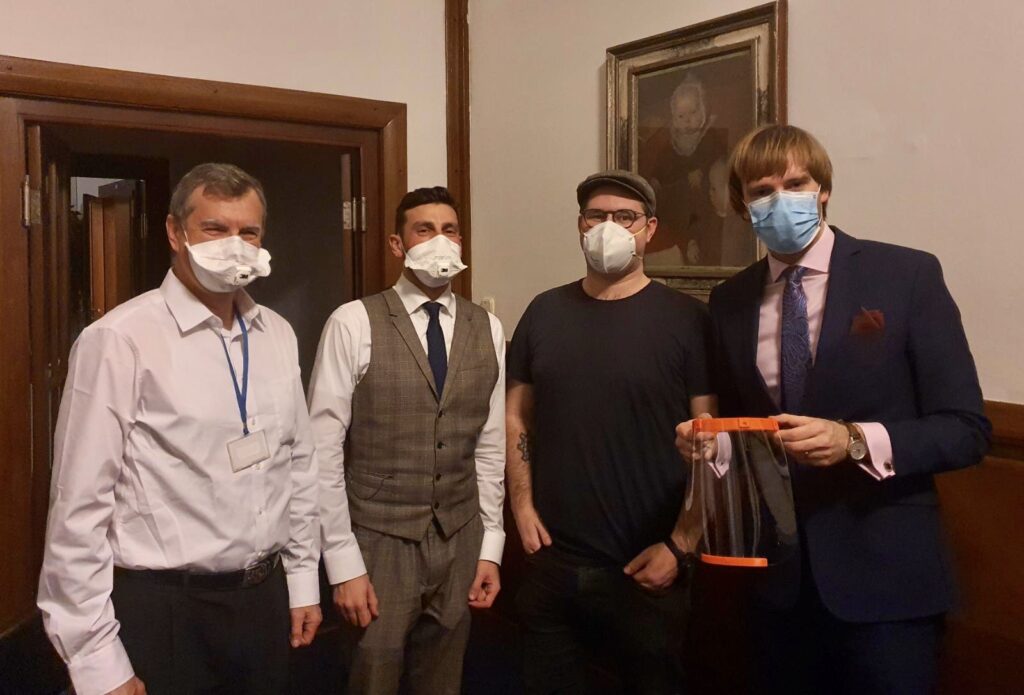 Presenting the prototype to the Czech Minister of Health Adam Vojtech
Presenting the prototype to the Czech Minister of Health Adam Vojtech
Thanks to our 3D printing farm, the largest in the world with over 500 3D printers, we are able to produce 800 pieces a day. Even at this rate, the farm is not actually being utilized fully for this project, only 1/5th of the printers are being used for this as we are bottlenecked by our laser cutter’s capacity to cut the clear visors. If we remove this bottleneck we could theoretically produce up to 4000 pieces a day. For now, this doesn’t affect our normal production and if we need we can add more 3D printers to the production. After all, we are world record holders with 1096 concurrently printing 3D printers, so capacity shouldn’t be a problem :-).
The materials required to manufacture one unit are less than $1 and that is without any quantity discounts when buying. We literally got materials around Prague during one afternoon.
As a starting point, we are donating 10.000 units to the Czech Ministry of Health and we are now sourcing more materials.
The design can be printed relatively safely by individuals after verifications in lower numbers to help local communities too.
 Protective shield parts being printed on our 3D printer farm
Protective shield parts being printed on our 3D printer farm
I want to get this to as many people who need it as soon as possible, around the world. If you guys have the tools and capacity for it, you can start preparing now, even before we have the final design. It’s a great time to give your printer a tuneup and to stock up on materials so you are ready to start printing as soon as we release the designs. I think most makerspaces should have the tools needed: a 3D printer, a laser cutter, and scissors – that’s all you need! Please keep in mind this is RC1 (release candidate), which still needs to be fully verified, but I will regularly update this article with new findings. So bookmark this page (I will be also tweeting out the updates.) if you want to help out.
Safety and sterilization and verification
The big question is the sterility of the production environment and the finished parts. You really don’t want to make things worse by producing things meant to fight the disease, while accidentally spreading it. ALWAYS check with a professional to ensure your setup or production is up to their standards and don’t be offended if they are cautious to accept your help. I cannot stress this enough, don’t make things worse and don’t create more trouble for those who are working so hard to keep us all safe and treat those who are sick.
Keep in mind that the virus can live on the plastic for 48-90 hours and plastics cannot be easily sterilized after use. So they are one-use only, at least until we find a way to reliably sterilize the printed parts!
Here are the precautions we are taking (these also apply to other 3D printed designs out there) and they are still pending validation – always check for updates of this article.
- The plastic is heated up to a high temperature during printing pretty much sterilizing the printed part, don’t let the part sit on the bed for hours where it can be contaminated again. Wear a fresh pair of gloves and surgical mask before removing the prints and put it directly into a fresh sealable bag. In our farm, we have the air completely exchanged every 2 minutes and it is filtered, this greatly helps reduce anything harmful in the air.
- When lasering the clear shields, leave the protective foils on so it can be removed before assembly and use. This greatly reduces any possible contamination. Also, pack it as an entire batch your laser can make at a time. Our laser can make 40pcs in one go, so when we open the laser, we collect all of them at once – again in fresh gloves while wearing a surgical mask. We put them into a sealable bag immediately. If your laser can only produce one at a time, make sure you are wearing fresh gloves for each part you produce.
- When cutting the elastic, we also wear gloves and surgical masks. Do not unpack more than you need to work on, reducing exposure to the air will reduce contamination.
Dentists from the Astella Clinic in Prague are among the first to test protective shields in practice
Design
As I mentioned before, the design is still pending verification in the field and will probably change over the course of the next day or two. The design will be appropriately updated on the PrusaPrinters. Right now it is completely safe to make one only for yourself!
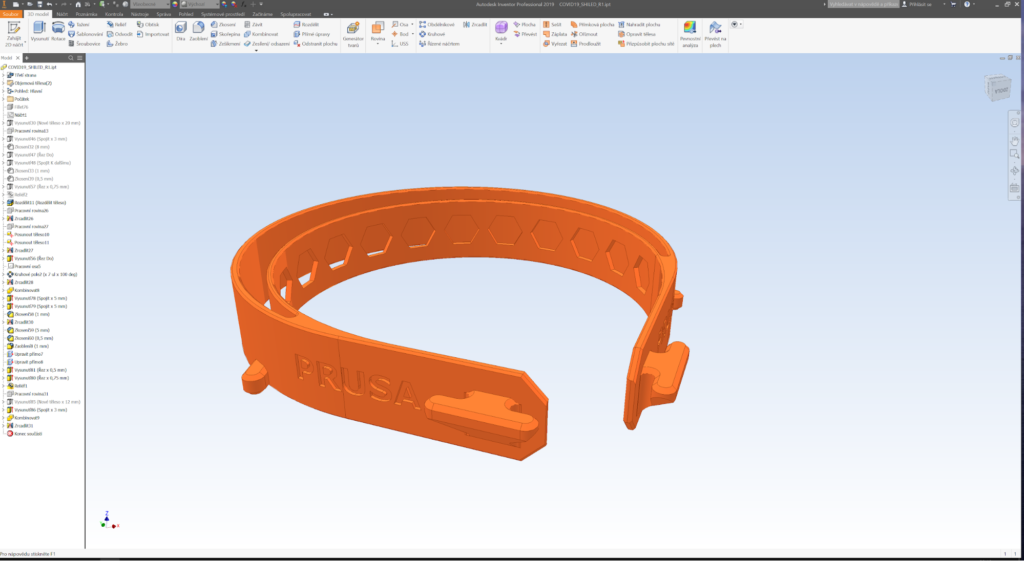 Designing the headband part of the protective shield
Designing the headband part of the protective shield
Some designs are available online right now, but they are usually very inefficient in utilizing the area of the printer’s surface. We had to start designing parts from scratch and we are able to fit 4 on the regular Original Prusa i3 MK3S bed, greatly increasing the farm’s efficiency. We took advantage of the properties of the plastic, designing the part compressed (bent) which helps with a snug fit on the head.
 4 pieces nested on the printbed
4 pieces nested on the printbed
We also found great elastic fabric with even spaced 10mm holes in the middle, greatly improving the adjustability. But pretty much anything similar can be used by simply cutting a 10mm hole in the fabric. We use a hot wire to cut the fabric which prevents the ends from fraying, but scissors and a lighter to melt the ends can be used too. A thick rubber band can be secured by making a knot with a loop.
 We took one of our automatic cutters we use for making fabric shields for MK3S wire harnesses and repurposed it for the new task
We took one of our automatic cutters we use for making fabric shields for MK3S wire harnesses and repurposed it for the new task
For the clear sheet, any clear laser cuttable plastic can be used – thickness ranging from 0.5mm to 1mm is recommended. The holes are the same size as produced by regular office hole punch and plastic can be cut by hand with scissors while using our design as a template. Even the plastic from a 2-liter bottle with straight sides can be used if there is no other material available.
Other ways to help the pandemic with 3D printing
 We also launched a new quick design competition for other 3D printable designs. The main goal is to quickly produce everyday necessities that might run out during quarantine, or they may save you from a potentially unsafe trip to the store. Things that you might also find useful when life gets back to normal.
We also launched a new quick design competition for other 3D printable designs. The main goal is to quickly produce everyday necessities that might run out during quarantine, or they may save you from a potentially unsafe trip to the store. Things that you might also find useful when life gets back to normal.
And one more thing. We assume that there are hundreds of projects like ours run around the world right now. If you are a part of any of them, please, e-mail us at [email protected] – we are especially interested in designs that have been proven to work (e.g. medically approved, used in the field, etc.). We will be happy to share all tested and approved tools on PrusaPrinters!
That is it for now, thank you all for your continued support and inspiration. This community is such a great example of what humanity can do when we all work together towards common goals. Keep being awesome!







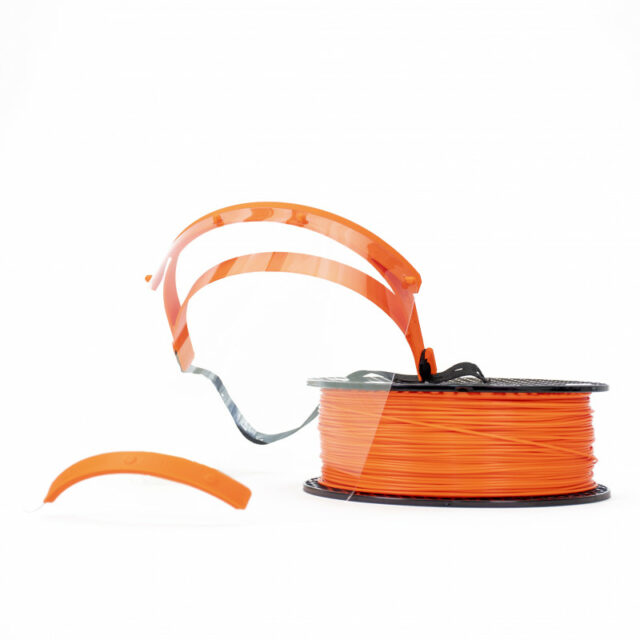
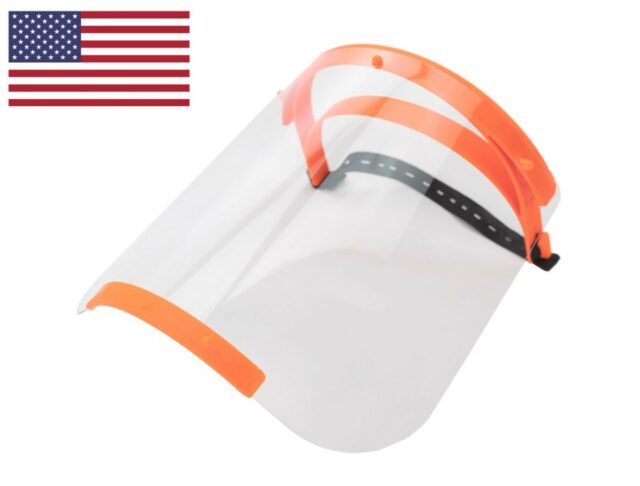
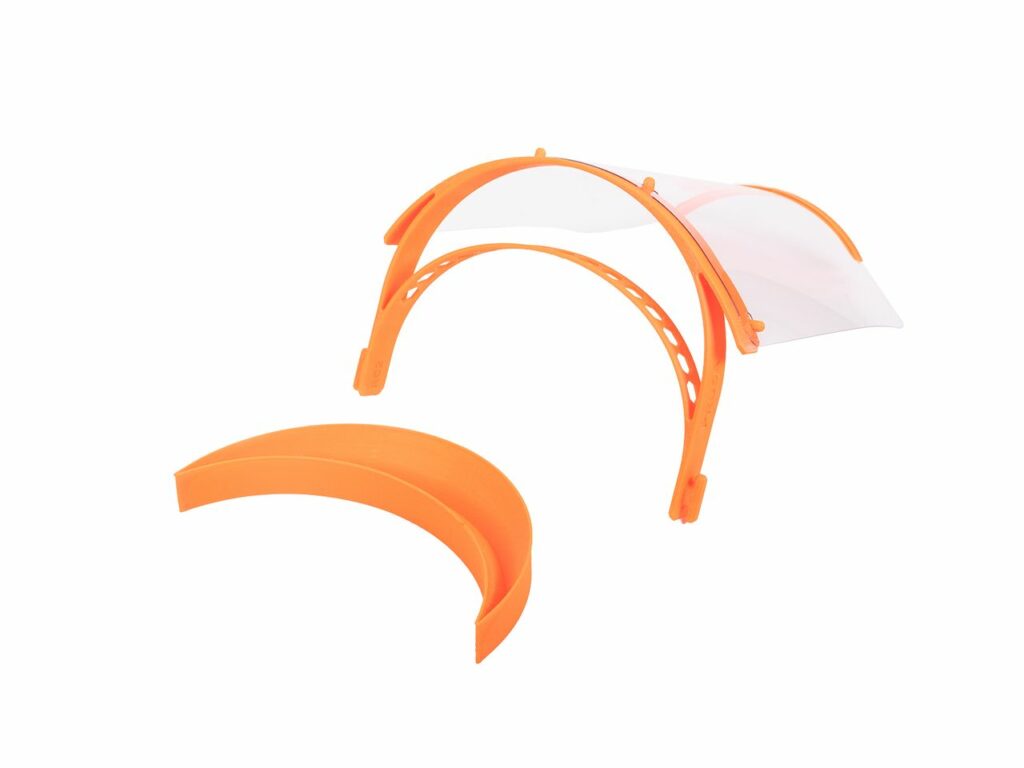
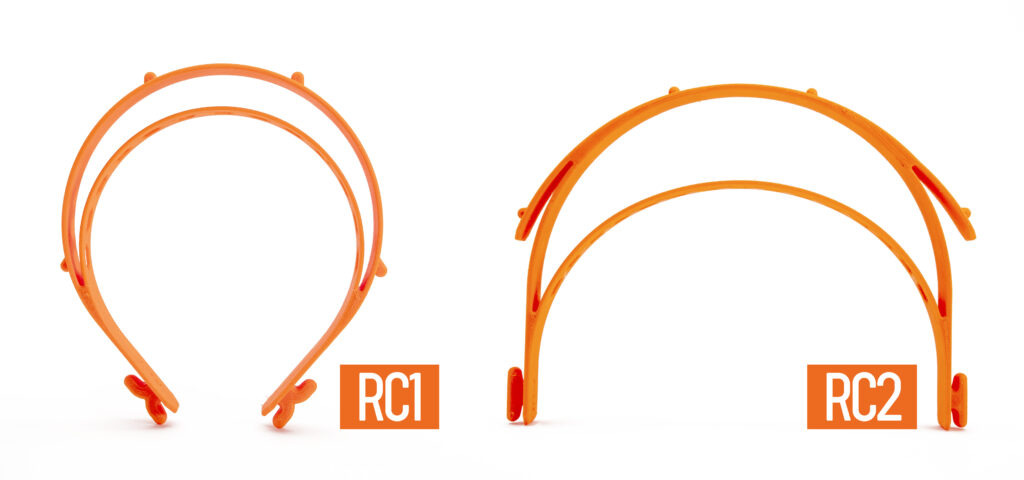
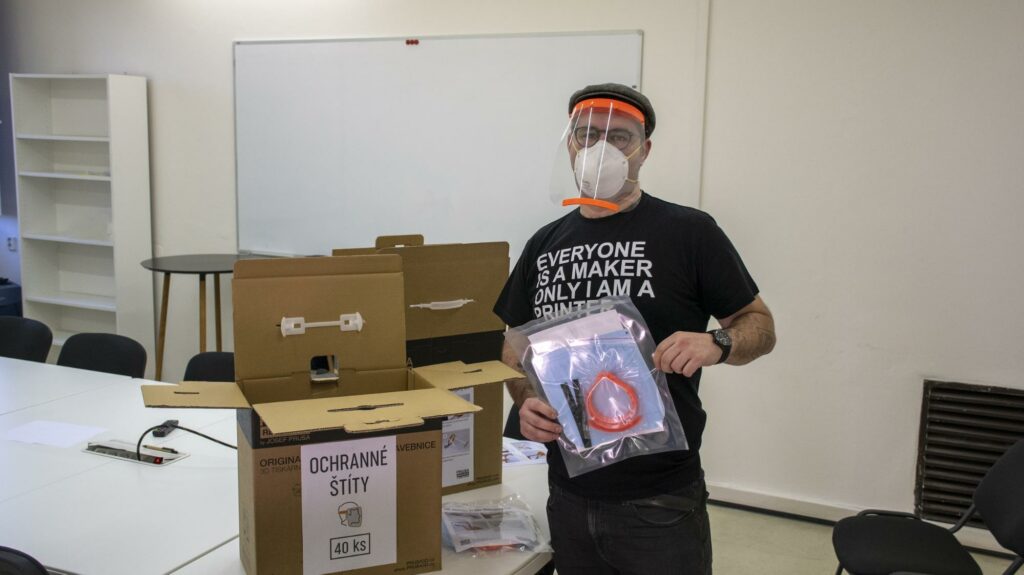
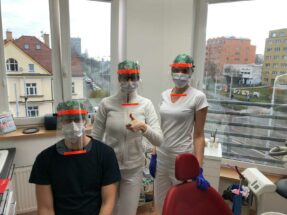
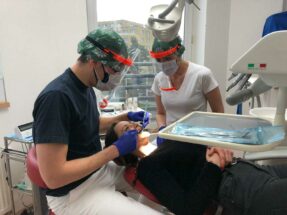
This may be dumb, but do you think overhead projector film sheets could substitute for the petg sheets? As a teacher, I have quite a few laying around my classroom. It may not be as sturdy, but doubling, or more, might help. I see on Amazon that the ones I have for laser printers are acetate sheets which are 4.5 mil thick (which is ~0.11 mm each? ). It might take a redesign for the thinner material.
Of course, I have no idea about durability, the porosity (like the respirator issue, but not?), etc., clarity of multiple sheets, and who knows what else. Just thought I would throw this out there and get some idea about it.
J. Mills
Actually I like the idea of using overhead projector film sheets. But not for medical personal like this mask is for, but for a private sheeld to be used if you can not avoid to go outside – like go buying something to eat. Any shild reduces contact with possible contamination from others. So printing a onetime-use shield with overhead projector film is a good idea.
Also the biggest effect of such a shield: You do not grab into your own face anymore. This behavior of grabbing in your own face is a so deep reflex, you nearly can not change it in short time. So if you wear such a shield, it reduces risks a lot: You do not get drops with virus directly into your face and you do not get your own hands into your face.
So if you print such a shield and use an Overhead foil, it is totaly O.K. for going to the supermarket; you dispose it at home, wash your hand and maybe take a shower.
But of course it is quite a difference if you make a sheeld for protecting yourself for a short time and making a sheeld for medical personal who have to wear it longer periods.
I just realized that I posted almost the identical reasoning for wearing a personal shield, only 30 minutes after your post (which I had not read in detail before I posted). I totally agree that stopping yourself from touching your face will make a big impact on your risk of infection.
As I said in my own comment, those that do not have overhead projector film, can use laminating film that was run through the laminating machine empty. That does not give a shield as perfectly clear as the overhead project film, but offers another way of using already available material now for personal protection. As overhead projectors are largely replaced by beamers, I guess not many of us have overhead film at home.
Stay safe everyone!
Great insight. I didnt think of the disposable clear part angle.
I’ve printed the Prusa parts. Now I need to make the 35 min drive to the school (closed, but there are things I need there to teach online for the next month–my state has closed schools until April 17th, but is not closing instruction). I’ll post results on the forum thingy, whether they turn out good or bad.
Another advantage is that you could hand cut them easily if you dont have a cnc laser…that’s two or so upgrades away for me….
Lastly, I also noticed on Amazon that some ohp sheets were made from PET, in case it matters. Another PET: A commenter below suggested clear 2 L drink bottles. It’s no longer there, but I found it later in the original article when I searching for his comment.
That was the first thing I thought too. Those overhead projector foils are easier obtainable than specific PET foils
We have a de facto table were teachers leave Unwantes Stuff. I have picked up 3 boxes, all nearly full, of overhead film. I have used the. For many things:
1. Cover slips for slides. Just cut em up.
2. Premade full sheet slide samples–I’m proud of this one. Teaching chem also, I frame the ohp sheet with masking tape, typically, into 6-8 zones. I then put different chemical samples onto each. I put another ohp sheet on top. We then compare powders to grainy materials to crystalline, etc., all on one sheet.
2.5. protip: to attach, put tape border around edges also and just bottom glue side tape to top layer. I’ve tried other methods with poor results.
3. High print quality–being sure that they work in your inkjet or laser or copiers first (they can really destroy you printer if not–fou d out the hard way). Most do not, btw, it’s stated. Anyway, I get great print quality on this that is shiny. I then attach it to a sheet of copy paper or colored paper. You can layer as needed. Hmmmm…
4. … Just thought one up–animation cells. I’ve had students do flip books or video animation of projectile motion each year. But using ohp sheets as cells as you take each frame could produce some cool results.
Sorry, I didnt mean to write all that.
J.S.M.
Ugh, sorry for all the grammar_spelling errors. I don’t type so well on a phone and didn’t notice. No edit feature.
Not dumb at all. This precisely what I did in order to make cheap and rapidly manufacturable face shields. No fancy tools required other than a 3D printer and staple gun.
http://daniepstein.com/daniepstein/3d-printable-face-shield/
Je suis dans la fabrication métallique et j’ai utilisé un masque de protection
pour projection metallique quand on disque et meule
j’ ai remplace l’écran qui me semblait trop petit par une bouteille de Soda sans motif en relief, découpée et fixée sur l anneau du casque
J ai également fait un circuit de ventilation forcée avec un petit ventilateur 60/60/10mm d’imprimante 3D qui projette l’air sur mon visage du haut vers le bas
j’ai une deuxième bouteille qui fait cheminée au dessus pour aspirer l’air plus haut avec une ouverture vers l’arrière
le ventilateur est alimenté par un e petite batterie 12v
L idée est de prendre l’air ou le risque de contamination est le moins risque et de le rejeter vers le bas dans mes vêtements
On pourrait peut être mettre un filtre dans la cheminée verticale d’aspiration ?? Bien a tous
J’ai oublié pour stériliser mon masque casque de prtection je le met dans une boite fermée avec de l’eau de javel le masque posé sur une grille pour qu’il ne touche pas le fond
Est ce une bonne idée et combien de temps faut il attendre ????
Je vis a Bruxelles
Bonne santé a tous
Ozone is rather good for sterilization?
Yep. https://www.thailandmedical.news/news/ozone-can-be-used-to-destroy-the-new-coronavirus-and-disinfect-areas
Finally a realistic way to help with COVID19, seems like everyone else was really set in making valves and masks. Big props to you guys for keeping things down to earth
UV lamp for resin care could sterilize plastic?
I looked into this. Sterilization needs about 250nm wavelength, stops working around 340nm. Curing uses 405nm.
Right, but given 250 nm UV LEDs are available too, would that be a suitable way to sterilize the plastic parts?
For example: https://www.alibaba.com/product-detail/high-power-uvc-uvb-uva-led_62402635618.html
I looked at that Alibaba link you provided.
Maybe it is just because I am in the US. But the cost of that LED is $28 with a minimum order of 10 pieces. Shipping to the US by FedEx is $2010.87! Total cost is $2290.87.
I don’t consider that a viable option.
Can you sterilize all or some of the parts by putting in a bleach solution (1/4cup bleach / 1gal water) for a minute and then let air dry?
Dobrý den,
absolutně chápu a taktéž nedoporučuji aby lidi tiskly respiratory protože už jen špatný handling snima může být riskantní jelikož virus na plastech potrvá několik hodin. Napsal jsem vám email přes vaši Josef Průša stránku kde jsem se představil a popsal o co jde můj design je definitivně nejlepší alternativa k samo ušitým maskám rád bych se s vámi o to podělil. Prosím zkontrolujte váš email.
I started a Facebook group and a hashtag to track things like this.
#3DPrinters4C19
Nylon 680! It can be sterilized by either Ethylene Oxide or Gamma, and can withstand 1-2 trips through an autoclave depending on how much deformation is acceptable. It is also printable on the i3 mk3s.
Great Idea, I work as a Critical Care Nurse and have had several Covid 19 patients, The cleaning wipes we use for surfaces can etch a haze into some plastics so I would use them as a disposable Item but as the primary care giver you can keep a shield at the entry door from the clean room to the negative pressure room. Maybe use a layer of insulating foam tape (the kind you use for drafty windows and doors) on the inside of the headpiece for comfort ???
thanks for your reply. It will be an expensive disposable face shield then. I wore rc2, the plastic is flexible and feels comfortable.
I remixed RC2 design and make one disposable version. It is now on thingiverse https://www.thingiverse.com/thing:4236534. Hope it can help people. Thanks
With regard to material for the clear shield I believe I can add an idea for those of us at home, that want to produce such a shield for themselves (rather than trying to buy some, while doctors need them really badly). I believe wearing such a shield in public in highly affected areas (e.g. when doing essential grocery shopping in a supermarket) makes much more sense than wearing homemade respiratory masks, I fully agree to your statements above on these.
In fact, touching your own face (oral or nasal mucosa or eyes) with contaminated hands is posing a serious threat for infection. This shield will not only block (some) droplets if someone sneezes into your face. It will also stop you from touching your face in an act of unthoughtfulness. Once you are back at home, you can wash your hands and take off the shield.
On the material for the shield: I have just run an empty laminating film through my document laminating machine as a test. The result is a relatively clear shield, which should be sturdy enough for this use case. It can even be made more sturdy by putting a folded paper stripe in between the two layers of the film on the left and right edge before running it through the machine.
The laminated film is not ultimately clear. So for a medical professional, it would probably be a bit irritating when worn all day long. But for a private individual that goes shopping in a crowded store for 15 minutes, I believe it is perfectly fine. I have been able to easily work on my computer while looking through this shield.
Laminating machines and film should be available in large quantities in offices around the world. And laminating documents has likely second priority these days. So let’s use these machines and films to produce these shields to protect all of us.
By the way: You guys are awesome! You truly deserve the success you have for years now! I am so proud to run one of your products (and have one more on back-order already).
Stay safe! All the best from Germany!
UV-light water purifier “pens” might work as a way to sterilize the mask.
I could not find the wave length of the light the pen gives off. The product descripiton claims it kill viruses. Wearing sunglasses while the UV is on seems like a good idea. https://www.mec.ca/en/product/5038-176/Classic-3-Water-Purifier-and-Pre-Filter?org_text=water%20purifier
Great idea. You are always a step ahead. I really wish that we as a community can help all together with our knowledge and tools to help that Corona infections don’t explode
Super, len tak ďalej.
Judging by the reports of doctors and nurses in italy getting infected when they were only wearing nose and mouth face masks I think this could make a big difference because the eyes have a soft membrane that the virus can pass through if sneezed droplets land on them. I am keen to print some when finalised.
Hello Josef,
Can I present it to the French authorities who are currently looking for “All alternative solutions allowing to protect the face (ex:” full visor “) allowing not to come into contact with the droplets potentially carrying the virus, but by guaranteeing comfort for the user”?
It is serious.
Thanks
It depends what they mean with “full visor”. Is it any kind of device that protecs the face from the front or like a full face mask, a helmet or goggles. This design solution does not. It will be helpul against spit, blood spatters, heavy/large droplets, dust and small debree flying around when drilling teeth.
But this virus is so contageous because it remains airborn for a considerable amount of time. And a virus being very small carried in this fluid called air. When the body moves, when you breathe in and out or someone coughs the air moves as well. To give you one example I’m worried about with this design solution…
When in contact with a patient or close by you move around. And so does your head. This type of shield is not fully closed. Shaped like a scoop it will act like scoop trapping contaminated air behind the shield, closer to a new host. For this shield to work sensibly it needs to cover the face entirely, like a good respirator.
Hi, any precise reference for the suitable clear laser cuttable plastic sheet, thickness ranging from 0.5mm to 1mm ? Online or elswhere ?
I was thinking of Heavy duty clear sheets for binding documents, but it seems to me that they are usually made of PVC and not laser cuttable.
Objective would be to make in our Fablab some to distribute to local Hospital Medical staff for free (or production price).
Best regards,
JMF
Ok found some reference: 0.5mm PETG sheets. One of the possible brands is Vivak.
My understanding, is that PVC sheets are not laser cuttable because of Chlore released. This is unfortunate as they are easy to find and cheap.
I wonder if Laminating pouches could do the job.
Here is a derrivative design that uses only laser plotter (no 3d printing). As a result one plotter produces a shield every 90 seconds and therefore we can speed up production many times. It stays on head even during violent head movements and is really comfortable to wear.
https://hackaday.io/project/170481-laser-cut-medical-shield
Hi, is there any information about how the edges of the lasered shield should be treated?
I assume that they will be sharp directly after lasercutting?
Do you have any experience about that?
I do not have a lasercutter on my own but I am about to talk to a manufacturer about this, so they can produce the shields.
Thank you very much and stay healty
Sebastian Z
They are not sharp at all. It’s ready to use straight out of laser.
Could you please share the STEP File or the F360 Project !
much appreciated !
Thanks.
I’m curious why these are not printed with a more open U shape – even wider open than the RC2 model – so that they could be nested one inside another on the print bed. Another possibility would be to make the inner band – the one that lies on the forehead – split in the middle with a simple tab and slot to fit it together to put on. Then the shields could be printed slightly more open to allow the nesting and more pieces per print run. This would especially be valuable for people who have access to larger-bed printers. Would this work?
Hi,
and another question concerning zur lasercutter. How much Laser-Power is needed to cut the shield? And how long does it take to make one?
Thanks
Sebastian
I’m completely new to 3D printing but would like to get started right away because of the pandemic. From start to finish—from buying printer and materials to producing and cutting parts for face shields—can anyone point me toward resources and tell me what to obtain and from where? Thanks.
Hello…what are the exact dimensions of the plastic you are using? I could not see that in the article.
Izopropyl alcohol: solution for sterile shields?
You wrote that germs may be an issue. Izopropyl alcohol is sometimes used in medical applications. Is there any problem with cleaning the shields (completely) or other PET, PC or PP sheets and prints made of PLA, PET-G or other common material using izopropyl alcohol in hospitals? May be then the shields (and other products in shortage) might be used more than once? If anybody knows the medically based answer – please reply.
It seems to me that combining the respirator & the face shield would reduce the cost, parts count & increase the speed of production, which in turn would make them more disposable.
Here is a possible path. Start with an ultra-clear plastic bag that would fit over a person’s head and had a cinch-up strap like a garbage bag. This strap would be used to sealed around the neck. Then initially, 3D print the filter parts that would mount through a hole in the bag. These parts would seal using an off-the-shelf flat rubber washer that was squeezed against the perimeter of the hole in the bag & the filter mount. Once the design was proven, the 3D printed parts could be shifted to injection molding & millions could be produced in short order.
Mr. Prusa, thank you for your great printer & working to solve this huge problem.
Hi! Thank you very much from Portugal! We are also having problem with the Corona Virus and we will be using your design! We have only made onde change, the distance between the pins was made 80-80-80, so that we could use acetate sheets with standard furation. They are not reusable, but we can improve the speed of production a lot. Any A4 acetate sheet can be transformed with a simple paper punch in a matter of seconds. We’ve let all your markings but included PT80 on the sides so that it could be perceptible that it was not the original one but a derivation. Like that, they can be identified. This is the website (https://ajudarportugal-37dcf.web.app/) where we are mobilizing people to make the production near the need of them.
Thanks once again!
updated website https://vamosajudarportugal.org/
Stupid question re sterilization: If the virus can’t survive on plastic for longer than 5 days, why wouldn’t cleaning the shields and then sealing them in a new bag for another 5 days work?
Can Prusa provide the 4-up nested 3MF files for the MK2S and MK3S ?
Hi, we fabricated some shields in our fablab.
We used overhead projector film sheets A4
Din3 would have been better because the visor is 24×24.
In our case the bottom part is shorter.
Also because of the thickness 0,1mm bottom 3d printed part isn’t usable (falls of).
You can see through, but when working with displays the picture isn’t 100% clear and you will notice some blurred reflections.
Does this also happen with the thicker PETG sheets?
All in all great usability, good design and you can wear it comfortably.
Openlab Hamburg
Hello, here is a company in San Diego printing these with 0.6 nozzles, which allow for faster print times. If you have the knowledge, try it out for yourself and if it works, spread the word. Thanks.
https://www.youtube.com/watch?v=YFo5TcGurSY
Hello,
we are printing something similar but much simple in Spain for hospitals , police, civil protection etc..
The main advantage of our simple version is rapid production (2 per hour) and easy to clean (feed back from medics…). Medics don’t like complex shape because it difficult to disinfect it.
Our solution is this:
https://www.facebook.com/rafael.avilestorres?__tn__=CH-R&eid=ARBALs0cBpkqfwGJIFFGQNJ6Ylm-4WYGfFELeADkli5XMYBE0g9ixw5-3oBs_uL5NWyLGnIAlPMKLtId&hc_ref=ARQbL1rgcL9bkcDqImQoAn5UfLq1T0DstKxbnTYwOeAMAOf3WBoa7oQ0QtVrA8_4-LU&fref=nf&__xts__[0]=68.ARBTOX8YNTJoeTEHlglZm6CnPR4RrP4UbLSCTrdjz7I7qHlprMHH5W0kzR-o3sNldqNfUUZrhvj7Y9YAmEXyIOYK7Iant1c9JrA1WjOfsYGauUgFs4t9JMTSI2er1ITAYBxV-25w5dGu017bEl-oldUfHU7h3YuHaeKc4EYuL6Jr0qKYj7WvjmbD5TWIl6pTt2f-MFTesafZi5aeyO1xF7eBEWpkrGZEnNdBR1nAm_D8efj2bH4VdPHe7S_D8hqlIoD_Y0RantXohx_zZAlYZzuvD7IsJLYkSUvuLEg-hoUVJvmRQswuTGS0RwK_iz1SF10C_gTUgb-K7gk4zKFC3k8
Hello:
I am trying to figure out if there is a specific type of 3D printer that must be used to make protective shields. Specifically I would like to know if our schools 3D printers have the ability to make these products. Any thoughts you have would be greatly appreciated
Hello everyone, is there any particular reason to use thicknesses between 0.5 and 1mm, could it be less?
It’s amazing to see how the 3D printing community has rallied together to support frontline workers with face shields and other essential gear. When working on projects like this, it’s important to make sure everything gets to where it’s needed safely and efficiently. That’s where companies like <,a href="https://beeprinters.com/">Bee Printers</a> can make a real difference—offering custom printing and packaging solutions that ensure your hard work reaches those who need it most, all while keeping things organized and professional. It’s inspiring to see everyone working together, and with the right support, we can make a huge impact!
Absolutely stunning folks – well done! Quick note regards the individual file for RC3 now available. It looks like it’s not quite manifold:on slicing, the gap between front and rear band gets filled. Nettfabb fixed it ok. Note, the quad file was fine.
Cheers,
Gerard
great article thanks for sharing so much knowledge. https://www.dgcustomerfirst.biz/
Has anybody modified the RC3 design to work with US three-hole punch dimensions. This design (https://www.thingiverse.com/thing:4237446) is RC2 but I need the stackable print version so I can batches overnight.
Hi guys, I quickly built this site to help: If anyone can offer 3d printing mask to our front line medical worker. You can publish your offers here. https://3dprintingmask.info/ hope it can help
It’s great that you’re producing face shields.
As a MD Anesthesiologist who needs much more protection during aerosolizing airway procedures, I invite you to consider also helping with full respirator and hood level protection. I have a 3D respirator and hood design ready to go…. https://bunnyscience.dozuki.com/Guide/HALO+Respirator+(Buildable+PAPR)/4?lang=en
We have the following products in stock now and you can check our website for more details.
Website: w w w . surgical3plyfacemask . com
Email : halfamedicalcosmeticforeigntra @ gmail . com
3 ply face mask
N95 face mask
Hand gloves
Surgical gown
Test Kits
Does anyone know who did the stacked models of the RC3 Prusa face shield? I would like to have at least a 2 and 4 stacked version of the USA version of the face shield. I am leading an effort in DFW (Dallas / Ft. Worth, Texas, USA) to print these.
Excellent work I think it will serve me when I return to work at https://www.apprentus.fr/
A brand picture needs to present your mascaras in engaging Mascara packaging to have a respectable effect at the bleeding edge of the customer considerations. We understand how to improve your arrangements and advantages with excellent mascara in a box.
Mascara Boxes
Wow … I’m impressed with the effort and hard work you put in the fast turnaround time. Keep in touch with Rush Custom Boxes for durable product boxes for your packaging needs. Here is the link:
https://www.rushcustomboxes.com/product-boxes/
This trusted US packaging company offers custom packaging boxes to small and large businesses worldwide. I believe you need a company for custom packaging to deliver protection shields to your customers safely.
3D printing, also known as additive manufacturing, is a digital file used to create a three-dimensional solid object. In the 3D printing process, sequential layers of material are laid down by the ‘3D printer’ until object creation is completed. Also, 3d printing is introduced in custom boxes for online businesses to pack their product.
https://www.packagingmines.com/
Here I mentioned the link of the USA based packaging company.
It’s amazing to see how the 3D printing community has rallied together to support frontline workers with face shields and other essential gear. When working on projects like this, it’s important to make sure everything gets to where it’s needed safely and efficiently. That’s where companies like <a href="https://beeprinters.com/">Bee Printers</a> can make a real difference—offering custom printing and packaging solutions that ensure your hard work reaches those who need it most, all while keeping things organized and professional. It’s inspiring to see everyone working together, and with the right support, we can make a huge impact!
ace shields and other essential gear. When working on projects like this, it’s important to make sure everything gets to where it’s needed safely and efficiently. That’s where companies like <a href="https://beeprinters.com/">Bee Printers</a> can make a real difference—offering custom printing and packaging solutions that ensure your hard work reaches those who need it most, all while keeping things organized and professional. It’s inspiring to see everyone working together, and with the right support, we can make a huge impact!
[Steam East US](https://steameastus.com)
<p>A brand picture needs to present your mascaras in engaging Mascara packaging to have a respectable effect at the bleeding edge of the customer considerations. We understand how to improve your arrangements and advantages with excellent mascara in a box.</p>
<p><a href="https://www.icustomboxes.com/mascara-boxes/" rel="nofollow ugc">Mascara Boxes</a></p>